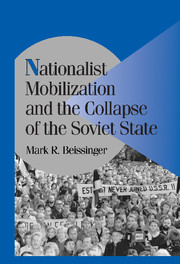Book contents
- Frontmatter
- Contents
- Illustrations
- Tables
- Acknowledgments
- 1 FROM THE IMPOSSIBLE TO THE INEVITABLE
- 2 THE TIDE OF NATIONALISM AND THE MOBILIZATIONAL CYCLE
- 3 STRUCTURING NATIONALISM
- 4 “THICKENED” HISTORY AND THE MOBILIZATION OF IDENTITY
- 5 TIDES AND THE FAILURE OF NATIONALIST MOBILIZATION
- 6 VIOLENCE AND TIDES OF NATIONALISM
- 7 THE TRANSCENDENCE OF REGIMES OF REPRESSION
- 8 RUSSIAN MOBILIZATION AND THE ACCUMULATING “INEVITABILITY” OF SOVIET COLLAPSE
- 9 CONCLUSION: NATIONHOOD AND EVENT
- Appendix I PROCEDURES FOR APPLYING EVENT ANALYSIS TO THE STUDY OF SOVIET PROTEST IN THE GLASNOST' ERA
- Appendix II SOURCES FOR THE COMPILATION OF EVENT DATA IN A REVOLUTIONARY CONTEXT
- Index
- Titles in the series
2 - THE TIDE OF NATIONALISM AND THE MOBILIZATIONAL CYCLE
Published online by Cambridge University Press: 18 November 2009
- Frontmatter
- Contents
- Illustrations
- Tables
- Acknowledgments
- 1 FROM THE IMPOSSIBLE TO THE INEVITABLE
- 2 THE TIDE OF NATIONALISM AND THE MOBILIZATIONAL CYCLE
- 3 STRUCTURING NATIONALISM
- 4 “THICKENED” HISTORY AND THE MOBILIZATION OF IDENTITY
- 5 TIDES AND THE FAILURE OF NATIONALIST MOBILIZATION
- 6 VIOLENCE AND TIDES OF NATIONALISM
- 7 THE TRANSCENDENCE OF REGIMES OF REPRESSION
- 8 RUSSIAN MOBILIZATION AND THE ACCUMULATING “INEVITABILITY” OF SOVIET COLLAPSE
- 9 CONCLUSION: NATIONHOOD AND EVENT
- Appendix I PROCEDURES FOR APPLYING EVENT ANALYSIS TO THE STUDY OF SOVIET PROTEST IN THE GLASNOST' ERA
- Appendix II SOURCES FOR THE COMPILATION OF EVENT DATA IN A REVOLUTIONARY CONTEXT
- Index
- Titles in the series
Summary
Certainly all historical experience confirms the truth that man would not have attained the possible unless time and again he had reached out for the impossible.
Max Weber, “Politics as a Vocation”Not all historical eras are alike. There are times when change occurs so slowly that time seems almost frozen, though beneath the surface considerable turbulence and evolution may be silently at work. There are other times when change is so compressed, blaring, and fundamental that it is almost impossible to take its measure.
Such were the rhythms of Soviet history. When Leonid Brezhnev died in November 1982, Soviet history seemed frozen in time, particularly when viewed in light of the massive upheavals that convulsed the Soviet state during its first thirty-five years of existence. A spirit of stability and normalcy had come to settle upon most of Soviet society in the decades following Stalin's rule, even within the complicated sphere of nationality relations.
Then, in late 1986, the unexpected happened: The longstanding rules constraining freedom of expression in the USSR began to unravel. The French Revolution began as neither a national nor a class struggle, but eventually became both. Glasnost' similarly did not begin as a nationalist explosion. It became one. “When perestroika began,” an Estonian sociologist later observed, “neither its chief architects nor the broad public were prepared for the possible rise of national movements.” The first major eruption of nationalism did not take place until almost a year and a half after glasnost' had begun – in February 1988 in Armenia and Azerbaijan – and had nothing to do with the secessionist issues that ultimately pulled apart the Soviet state.
- Type
- Chapter
- Information
- Publisher: Cambridge University PressPrint publication year: 2002



